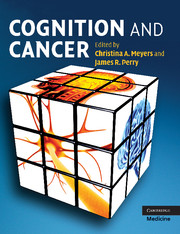Book contents
- Frontmatter
- Contents
- List of contributors
- Preface
- Section 1 Cognition and the brain: measurement, tools, and interpretation
- 1 Introduction
- 2 Clinical neuropsychology
- 3 Brain imaging investigation of chemotherapy-induced neurocognitive changes
- 4 Role of neuropsychological assessment in cancer patients
- 5 Neuropsychological assessment of adults with cancer
- 6 Neuropsychological assessment of children with cancer
- Section 2 Effects of cancer and cancer treatment on cognition
- Section 3 Interventions and implications for clinical trials
- Index
- Plate section
- References
6 - Neuropsychological assessment of children with cancer
Published online by Cambridge University Press: 13 August 2009
- Frontmatter
- Contents
- List of contributors
- Preface
- Section 1 Cognition and the brain: measurement, tools, and interpretation
- 1 Introduction
- 2 Clinical neuropsychology
- 3 Brain imaging investigation of chemotherapy-induced neurocognitive changes
- 4 Role of neuropsychological assessment in cancer patients
- 5 Neuropsychological assessment of adults with cancer
- 6 Neuropsychological assessment of children with cancer
- Section 2 Effects of cancer and cancer treatment on cognition
- Section 3 Interventions and implications for clinical trials
- Index
- Plate section
- References
Summary
Introduction
Neuropsychology, broadly defined, is the study of brain–behavior relationships. The term was coined by William Osler in the early 1900s and gained wider appeal in the 1960s. The field was influenced by pioneers in neuroanatomy, neurology, and physiology, who began to explore the brain's functionality (Broca, 1865; Hughlings-Jackson, 1931; Lashley, 1950; Wernicke, 1874). Modern neuropsychology represents a blend of careful clinical observation grounded in the pioneering work of Alexandr Luria (1973), and a more actuarial approach that utilizes psychometric instruments to describe and quantify an individual's functioning (Halstead, 1947; Reitan, 1974). Neuropsychology has become a science of human behavior as it is influenced by brain functioning and by social, psychological, and cultural contexts.
Pediatric neuropsychologists are concerned with developmental issues and take into account the genetic, medical, environmental, behavioral, and sociocultural influences that impact the maturation of a child (Baron, 2004). The human nervous system is never static and development occurs across the lifespan. However, the rapidity of development in childhood and adolescence calls for a specific developmental focus when conducting evaluations with this age group.
At birth, infants have more than 100 billion neurons (Berger, 2005). In the first 2 years of life the brain undergoes a period termed transient exuberance when as many as 15 000 new connections are established per neuron (Thompson, 2000). Following this period of rapid growth, there is a period of rapid elimination of synapses called “pruning” that peaks in adolescence and is variable across different brain regions (Kolb & Wishaw, 2003).
- Type
- Chapter
- Information
- Cognition and Cancer , pp. 56 - 80Publisher: Cambridge University PressPrint publication year: 2008

